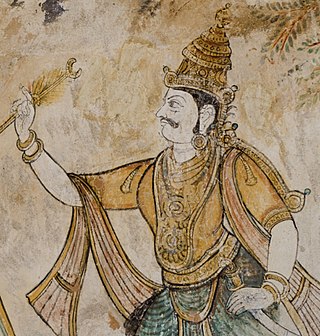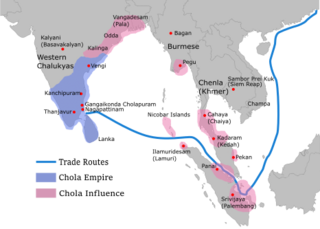
Uttama Chola also known as Madhurantaka, was a Chola Emperor who ruled from 980 CE to 985 CE in present-day Tamil Nadu, India. According to Tiruvalangadu plates of Rajendra Chola, Madhurantaka Uttama Chola's reign is placed after Aditya II. The latter may have been a co-regent of Parantaka II and seems to have died before he could formally ascend the throne. Uttama was the cousin of Parantaka II and was the son of the illustrious Sembiyan Mahadevi and Gandaraditya.

Rajaraja I, often described as Rajaraja the Great, or Mummudi Chola as was a Chola emperor who reigned from 985 CE to 1014 CE. He was the most powerful Tamil king in South India during his reign and is remembered for reinstating the Chola influence and ensuring its supremacy across the Indian Ocean.

Kulottunga I also spelt Kulothunga, born Rajendra Chalukya, was a Chola Emperor who reigned from 1070 CE to 1122 CE succeeding his cousin Athirajendra Chola. He also served as the Eastern Chalukya king from 1061 CE to 1118 CE, succeeding his father Rajaraja Narendra. He is related to the Chola dynasty through his mother's side and the Eastern Chalukyas through his father's side. His mother, Ammangaidevi, was a Chola princess and the daughter of emperor Rajendra I. His father was king Rajaraja Narendra of the Eastern Chalukya dynasty who was the nephew of Rajendra I and maternal grandson of Rajaraja I. According to historian Sailendra Nath Sen, his accession marked the beginning of a new era and ushered in a period of internal peace and benevolent administration.

The Chola dynasty was a Tamil thalassocratic empire of southern India and one of the longest-ruling dynasties in world history. The earliest datable references to the Chola are from inscriptions dated to the 3rd century BCE during the reign of Ashoka of the Maurya Empire. As one of the Three Crowned Kings of Tamilakam, along with the Chera and Pandya, the dynasty continued to govern over varying territories until the 13th century CE. The Chola Empire was at its peak and achieved imperialism under the Medieval Cholas in the mid-9th century CE.

Western Ganga was an important ruling dynasty of ancient Karnataka in India which lasted from about 350 to 1000 CE. They are known as "Western Gangas" to distinguish them from the Eastern Gangas who in later centuries ruled over Kalinga. The general belief is that the Western Gangas began their rule during a time when multiple native clans asserted their freedom due to the weakening of the Pallava empire in South India, a geo-political event sometimes attributed to the southern conquests of Samudra Gupta. The Western Ganga sovereignty lasted from about 350 to 550 CE, initially ruling from Kolar and later, moving their capital to Talakadu on the banks of the Kaveri River in modern Mysore district.

Tamil copper-plate inscriptions are copper-plate records of grants of villages, plots of cultivable lands or other privileges to private individuals or public institutions by the members of the various South Indian royal dynasties. The study of these inscriptions has been especially important in reconstructing the history of Tamil Nadu. The grants range in date from the 10th century C.E. to the mid-19th century C.E. A large number of them belong to the pandyas, the Cholas. These plates are valuable epigraphically as they give us an insight into the social conditions of medieval South India; they also help us fill chronological gaps in the connected history of the ruling dynasties. For example, the Leyden grant of Parantaka Chola and those of Parakesari Uttama Chola are among the most important, although the most useful part, i.e., the genealogical section, of the latter's plates seems to have been lost.

Vijayalaya Chola was a king of South India who founded the imperial Chola Empire. He ruled over the region to the north of the river Kaveri. Vijayalaya Chola is one of the descendants of famous Sangam age Chola king Karikala Chola. He was succeeded by his son Aditya Chola I, who laid the foundation of Imperial Chola Empire.

Parantaka Chola I was a Chola emperor who ruled for forty-eight years, annexing Pandya by defeating Rajasimhan II and in the deccan won the battle of Vallala against Rashtrakutas which happened before 916 CE. The best part of his reign was marked by increasing success and prosperity.

Kulothunga III was a Chola emperor who ruled from 1178 to 1218 CE, after succeeding his elder brother Rajadhiraja II. Kulothunga Chola III gained success in war against his traditional foes. He gained victories in war against the Hoysalas, Pandyas of Madurai, Cheras of Venad, the Sinhalese kings of Polonnaruwa, as well as the Chodas of Velanadu and Nellore. He also restored Chola control over Karur, which were ruled by the Adigaman chiefs as vassals of the Cholas. He drove out the Hoysalas under Veera Ballala II who had made inroads in the Gangavadi and adjoining areas of Tagadur in Kongu country in an effort expand their territory. However, during the last two years of his reign, he lost in war to the resurgent Pandyas, heralded a period of steady decline and ultimately, demise of the Cholas by 1280 CE. Kulottunga III had alliances with the Hoysalas. The Hoysala king Veera Ballala married a Chola queen called Cholamahadevi and gave his daughter Somaladevi in marriage to Kulottunga III.

The earliest undisputed deciphered epigraphy found in the Indian subcontinent are the Edicts of Ashoka of the 3rd century BCE, in the Brahmi script.
Indian copper plate inscriptions are historical legal records engraved on copper plates in India.

The political history of medieval Karnataka spans the 4th to the 16th centuries, when the empires that evolved in the Karnataka region of India made a lasting impact on the subcontinent. Before this, alien empires held sway over the region, and the nucleus of power was outside modern Karnataka. The medieval era can be broadly divided into several periods: The earliest native kingdoms and imperialism; the successful domination of the Gangetic plains in northern India and rivalry with the empires of Tamilakam over the Vengi region; and the domination of the southern Deccan and consolidation against Muslim invasion. The origins of the rise of the Karnataka region as an independent power date back to the fourth-century birth of the Kadamba Dynasty of Banavasi, the earliest of the native rulers to conduct administration in the native language of Kannada in addition to the official Sanskrit. This is the historical starting point in studying the development of the region as an enduring geopolitical entity and of Kannada as an important regional language.

The Tondaiman family were Tamil rulers of the ancient Tondai Nadu (Tondaimandalam) division of Tamilakkam in South India. Their capital was at Kanchipuram.
Ballari pronounced is a historic city in Bellary district in Karnataka state, India.

About 25,000 inscriptions found in Karnataka and states near by belongs to Kannada rulers like Kadambas, Western Ganga Dynasty, Rashtrakuta, Chalukya, Hoysala and Vijayanagara Empire. Many inscriptions related to Jainism are unearthed. The inscriptions generally found are on stone (Shilashasana) or copper plates (Tamarashasana). The Kannada inscriptions found on historical Hero Stone, coin and temple wall, piller, tablet and rock edict. These Inscription have contributed towards Kannada literature and helped to classify as Proto Kannada, Pre Old Kannada, Old Kannada, Middle Kannada and New Kannada. Inscriptions depicts culture, tradition and prosperity of those era. The world wide recognized literature Ramayana and Mahabharata are transferred through generation by these Inscription Hazara Rama Temple and Aranmula Parthasarathy Temple are the best example.

The Vaikunta Perumal Temple in Kanchi, a village in the South Indian state of Tamil Nadu, is dedicated to the Hindu god Vishnu. The temple is constructed in the Dravidian style of architecture. Vishnu is worshipped as Vaikunta Perumal and his consort Lakshmi as Anandavalli. The temple was originally built by Pallavan, with later additions from the Chola. The temple is known for the inscriptions indicating the democratic practises of electing representatives for the village bodies during the regime of Parantaka Chola.

Boothi Vikramakesari was a Velir Irukkuvel commander of the Chola Empire. He is best remembered for building the Moovar Koil temple complex, a collection of "Three temples" in the village of Kodumbalur, 36 kilometres from Pudukkottai in Tamil Nadu, India. His family was related to the Cholas by marriage. His mother was a Chola princess Anupama. She is the younger sister of Chola prince Arindama.

Ko Kizhan Adikal Ravi Neeli was the traditional title of the queens/princesses of the Chera Perumal kingdom in medieval south India. It was initially assumed that Kizhan Adikal was a proper given name.

Tamil dynasties are the kingdoms who ruled over present day Tamil Nadu, Sri Lanka, Andhra Pradesh, Karnataka, Kerala and Odisha. These include the Pallavas, the Pandyas, the Cholas and the Cheras.
Manimangalam is a small town located in the Kanchipuram district of Tamil Nadu state in Southern India, famous for its ancient temples and inscriptions documenting the history of the ancient Tamil kings















